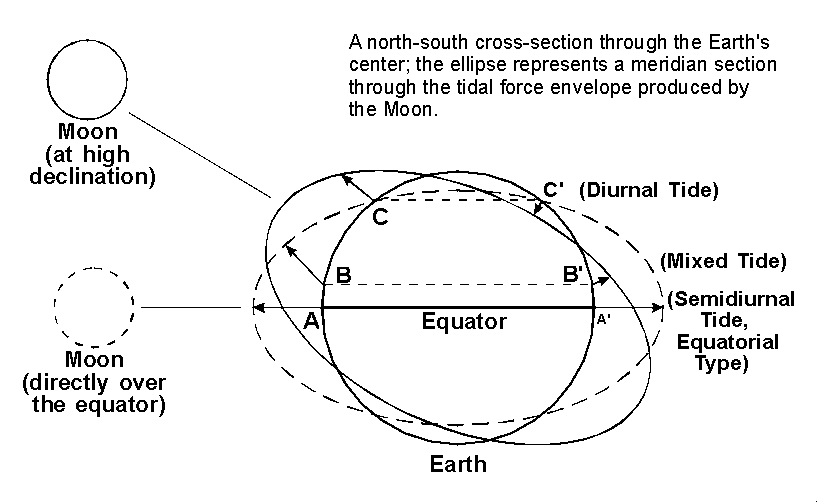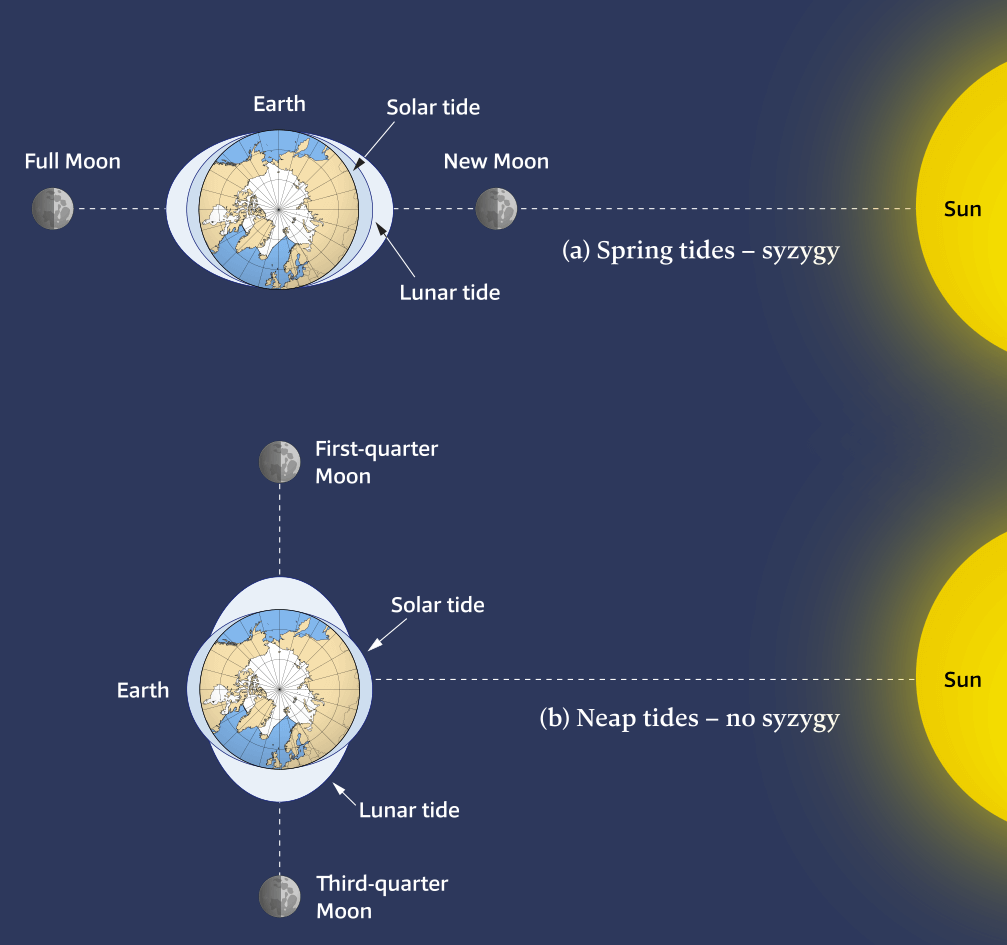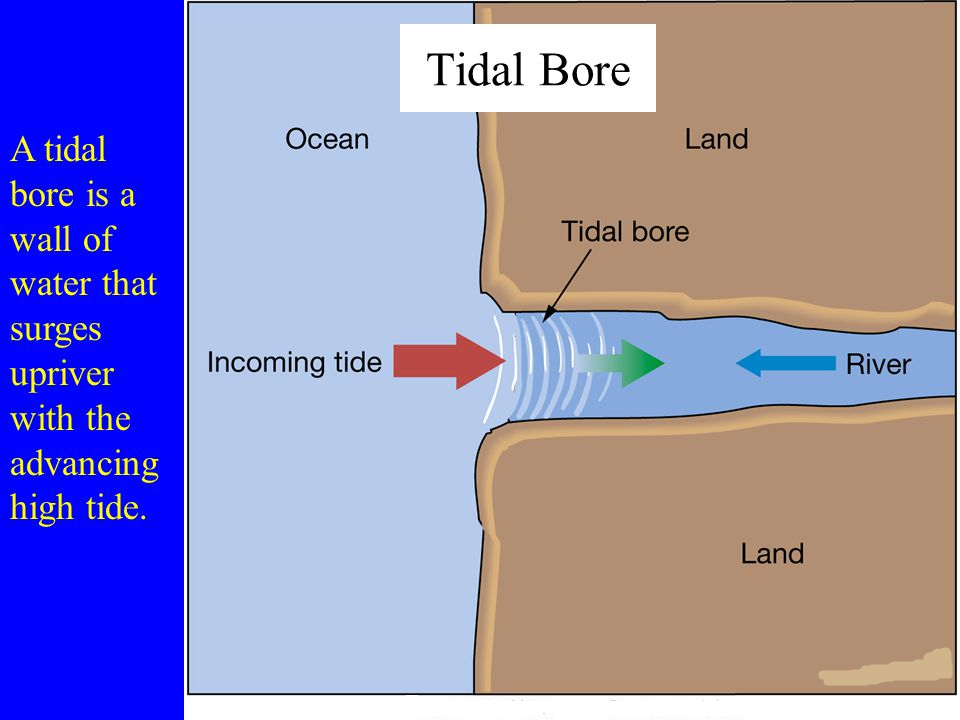- Home
- Prelims
- Mains
- Current Affairs
- Study Materials
- Test Series
Tidal currents
- Tides are long-period waves that roll around the planet as the ocean is pulled by the moon''s and sun''s gravitational forces. They are the rise and fall of sea levels caused by the combined effects of the gravitational forces exerted by the Moon, the Sun, and the rotation of the Earth.
- Tides are driven primarily by the gravitational interaction between Earth and the Moon, with the Sun also playing a smaller but significant role.
Relationship Between Gravitational Forces and Tides
- The creation of tides involves a delicate interplay between the gravitational forces of the Earth, Moon, and Sun. While gravity acts to pull objects toward one another, the centrifugal force acts to push them apart.
- The Moon''s gravitational pull is strongest on the side of the Earth that happens to be facing the Moon, causing the water in the oceans to bulge out in the direction of the moon. T
- his creates a high tide. At the same time, another high tide occurs on the opposite side of the Earth due to the centrifugal force created by the Earth spinning on its axis. The areas in between these bulges experience low tide.
- The position of the Sun relative to the Moon and Earth also influences the tides.
- When the Moon and Sun align (at the new moon or full moon), their gravitational forces combine to create higher high tides and lower low tides, known as spring tides.
- When the Moon and Sun are at right angles to each other (first quarter and last quarter moon), their gravitational forces partially cancel each other out, resulting in neap tides, where the difference between high and low tides is smallest.

Tidal Currents
- Tidal currents are the horizontal movement of water caused by the rising and falling of the tides. As the tide rises, water moves towards the coast, causing a "flood current."
- Conversely, as the tide falls, water moves back towards the sea, causing an "ebb current." In some locations, there is a period of little or no current at high or low tide, known as "slack water."
Types of Tides
Based on Frequency
Tides can be categorized based on their frequency:
- Semi-diurnal Tides: These occur twice daily and are common in the Atlantic Ocean. They result in two nearly equal high tides and two low tides each day.
- Diurnal Tides: These occur once daily and are common in some locations in the Gulf of Mexico and the western Pacific Ocean. They result in one high tide and one low tide each day.
- Mixed Tides: These occur twice daily and are common in the Pacific Ocean. They result in two unequal high tides and two unequal low tides each day.

Based on the Sun, Moon, and Earth (SME) Position
Tides can also be categorized based on the relative positions of the Sun, Moon, and Earth:
- Spring Tides: Spring tides occur when the Sun, Moon, and Earth are aligned (during the full moon and new moon). The combined gravitational effect of the Moon and Sun leads to higher high tides and lower low tides.
- Neap Tides: Neap tides occur when the Sun and Moon are at right angles to each other (during the first and last quarter moon). The gravitational forces partially cancel each other out, resulting in less extreme tides.

Importance of Tides
Tides have a significant impact on our planet and daily life. They influence coastal ecosystems, assist in navigation, influence human activities like fishing and surfing, and even have potential for renewable energy generation.
- Ecological Importance: Tides are crucial to the health of many coastal and marine ecosystems. They influence the distribution of organisms, nutrients, and oxygen in these ecosystems, and they create unique habitats like intertidal zones, which support a wide variety of life forms.
- Navigation: For hundreds of years, tides have played a crucial role in navigation. Knowledge of tides is essential for safe and efficient navigation, particularly in coastal waters.
- Fishing and Recreation: Tides can influence the best times for fishing and surfing. Certain fish are more active during particular tide stages, and tidal currents can create ideal wave conditions for surfing.
- Renewable Energy: Tidal movements hold potential for renewable energy generation. Tidal energy is predictable and can generate significant power. Tidal turbines and tidal barrage power plants are two examples of how we can harness this energy.
Tides are a complex yet fascinating phenomenon resulting from the gravitational interactions between the Earth, Moon, and Sun. Their impact extends beyond the simple rise and fall of sea levels, influencing diverse ecological systems, human activities, and even renewable energy production.
Tidal bores
 A tidal bore occurs along a coast where a river empties itself into an ocean or sea. It is a strong tide that pushes a river against its current. For the formation of tidal bore, specific conditions have to be met such as:
A tidal bore occurs along a coast where a river empties itself into an ocean or sea. It is a strong tide that pushes a river against its current. For the formation of tidal bore, specific conditions have to be met such as:
1) The river emptying in the ocean must be fairly shallow.
2) The estuary formed by the river must be wide and flat.
3) The tidal range of the coast must be quite large-usually at least 6 m.
Most notable example is the Qiantang River in China. Other examples are that of Batang river and Amazon River.
The tidal current is different from bores as tide and the associated currents are a fairly predictable phenomenon. However, formation of tidal bores requires meeting of very specific conditions. Also, bores can be quite destructive and lead to uprooting of vegetation, killing animals and swallowing surfers. The unpredictability also means that they are not very beneficial for harnessing energy.
Wobble Effect of Moon
According to a recent study, the Wobble effect of the Moon is expected to lead to more flooding on Earth in the middle of the next decade.
Key Finding of Study:
- The study aimed to untangle all of those variables in an effort to improve predictions about the future of floods.
- Rising temperatures caused by greenhouse gas emissions are not the only cause of higher flood risks and the interplay of many variables that push and pull at ocean levels is also responsible.
- The study warned the wobble to heighten high tides in the middle of the 2030s, but it also showed that this prediction does not apply uniformly to every coastline everywhere.
Moon Wobble
- It is a regular oscillationthat humans have known about for centuries.
- It is one of many factorsthat can either exacerbate rising sea levels or counteract them, alongside other variables like weather and geography.
- It was first documented way back in 1728.
- The wobble takes over an 6-year period to completeand continues in a cyclic fashion.
Cause:
- The high tides are caused mostly by the pull of the moon’s gravityon a spinning Earth and on most beaches, causing two high tides every 24 hours.
- The moon also revolves around the Earthabout once a month, and that orbit is a little bit tilted.
- The path of the moon’s orbit seems to fluctuate over time, completing a full cycle(referred to as a nodal cycle) every 18.6 years.
- At certain points along the cycle, the moon’s gravitational pullcomes from such an angle that it yanks one of the day’s two high tides a little bit higher, at the expense of the other.
- It does not mean that the moon itself is wobbling, nor that its gravity is necessarily pulling at our oceans any more or less than usual.
- The high tide floodingrelated to climate change is expected to break records with increasing frequency over the next decade.
Effects of wobble:
- It could cause high tide levels at a beach to oscillate by 1 or 2 inches over the course of its long cycle.
- In half of this lunar cycle, Earth’s regular daily tides are diminished, with high tides lower than usual and low tides higher than usual.
- In the cycle’s other half, the situation is reversed, with high tides higher and low tides lower.
- The moon wobbles impact the gravitational pull of the moon, and therefore, indirectly influences the ebb and flow of tides here on the Earth.
- The lunar cycle is expected to shift again by mid-2030, and in the coming phase, the tides will amplify once again.









 Latest News
Latest News
 General Studies
General Studies